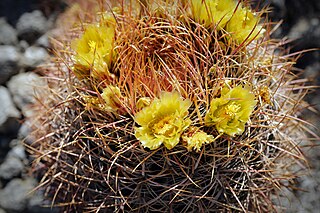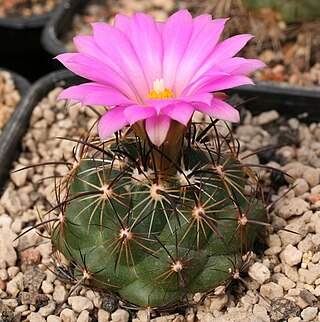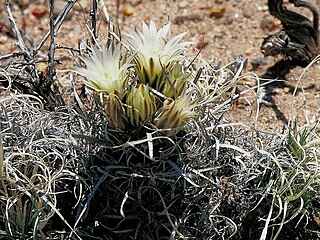
Echinocereus engelmannii, the strawberry hedgehog cactus or Engelmann's hedgehog cactus, is a cactus commonly found in desert areas of the southwestern United States and the adjacent areas of Mexico, including the states of California, Nevada, Utah, Arizona, Baja California and Sonora.

Ferocactus cylindraceus is a species of barrel cactus which is known by several common names, including California barrel cactus, Desert barrel cactus, compass barrel cactus, and miner's compass. It was first described by George Engelmann in 1853.

Pelecyphora vivipara is a species of cactus known by several common names, including spinystar, viviparous foxtail cactus, pincushion cactus and ball cactus. It is native to North America, where certain varieties can be found from Mexico to Canada. Most of these varieties are limited to the Mojave and Sonoran Deserts. The species epithet "vivipara" is due to the species' viviparous reproductive habit.

Cochemiea tetrancistra is a species of fishhook cactus known by the common name common fishhook cactus. It is native to the Mojave and Sonoran Deserts of northern Mexico and the southwestern United States, where it grows in a variety of desert habitat types.

Pelecyphora minima is a rare species of cactus known by the common names Nellie cory cactus, Nellie's pincushion cactus, birdfoot cactus, and others. It is a very popular species among cactus collectors. This is one reason why it is a highly endangered species in the wild today. This cactus is found only in Brewster County, Texas, in the United States, where there are three populations remaining near Marathon. The cactus is limited to one outcrop in the Marathon Uplift, where it grows in rocky novaculite soils. It was added to the endangered species list in 1979.

Coryphantha ramillosa is a rare species of cactus known by the common names bunched cory cactus and whiskerbush. It is native to the border region between Texas in the United States and Coahuila in Mexico. Because it was believed to be rare and threatened by a number of processes, it was federally listed as a threatened species of the United States in 1979.

Pelecyphora sneedii is a rare species of cactus known by the common names Sneed's pincushion cactus and carpet foxtail cactus. It is endemic to the Chihuahuan Desert of the southwestern United States and northwestern Mexico. It is a small, variable cactus with a lengthy taxonomic history, and is often subdivided into a number of subspecies or varieties. It is usually found on steep, rocky habitats, primarily of limestone geology, in desert scrub or coniferous forest. A species of conservation concern, P. sneedii faces threats from poaching, urban encroachment, and wildfires.

Echinocereus fendleri is a species of cactus known by the common names pinkflower hedgehog cactus and Fendler's hedgehog cactus. It is named in honor of Augustus Fendler.

Echinocereus viridiflorus is a species of cactus known by the common names nylon hedgehog cactus, green pitaya, and small-flowered hedgehog cactus. It is native to the central and south-central United States and northern Mexico, where it can be found in varied habitat types, including desert scrub, woodlands, dry grasslands, and short-grass prairie.

Sclerocactus mariposensis, synonyms including Echinomastus mariposensis and Neolloydia mariposensis, is a rare species of cactus known by the common names Lloyd's fishhook cactus, golfball cactus, silver column cactus, and Mariposa cactus. It is native to a section of territory straddling the border between Brewster County, Texas, in the United States, and the states of Coahuila and Nuevo León in northeastern Mexico. It has been federally listed as a threatened species in the United States since 1979.

Pediocactus bradyi is a very rare species of cactus known by the common names Brady's pincushion cactus, Brady's hedgehog cactus, and Marble Canyon cactus. It is endemic to Arizona in the US, where it is restricted to Marble Canyon in Coconino County, though its exact distribution is not generally advertised due to poaching concerns. It is limited to a specific type of soil, it has a small distribution, and the species is threatened by a number of human activities. This has been a federally listed endangered species of the United States since 1979.

Pediocactus peeblesianus is a rare species of cactus known by the common names Navajo pincushion cactus. It is endemic to the state of Arizona in the United States. The species is named after the Arizona botanist Robert Hibbs Peebles.

Sclerocactus papyracanthus is a species of cactus known by the common names paperspine fishhook cactus, grama grass cactus, paper-spined cactus, and toumeya. It is native to North America, where it occurs from Arizona to New Mexico to Texas and into Chihuahua, Northeastern Mexico.

Pachycereus pecten-aboriginum is a columnar cactus plant native to Mexico. They can grow up to 15 m (49 ft) high. The trunk of this species is 1.2 to 5.0 m tall and the fruits are large and burr-like. The specific name, pecten-aboriginum, is from the Latin, and means "native combs". It was inspired by the use of the fruits as hair combs.

Ferocactus hamatacanthus, commonly named Turk's Head, is a barrel cactus in the tribe Cacteae.

Echinocereus fasciculatus, commonly known as pinkflower hedgehog cactus, is a clumping cactus (Cactaceae) with brilliant magenta flowers and long spines found in the Sonoran Desert.
Lucretia Breazeale Hamilton (1908–1986) was an American botanical illustrator, who was considered an expert on southwestern United States flora. She illustrated numerous technical papers for the University of Arizona and 16 books. She was posthumously recognized with a Desert Willow cultivar named in her honor and induction into the Arizona Women's Hall of Fame.

Pelecyphora macromeris, the nipple beehive cactus, is a species of cactus in the United States and Mexico. In the Chihuhuan Desert, it is common and has a wide range.

Pelecyphora robbinsiorum known by the common names Cochise pincushion cactus and Cochise foxtail cactus is a species of flowering plant in the family Cactaceae.



















